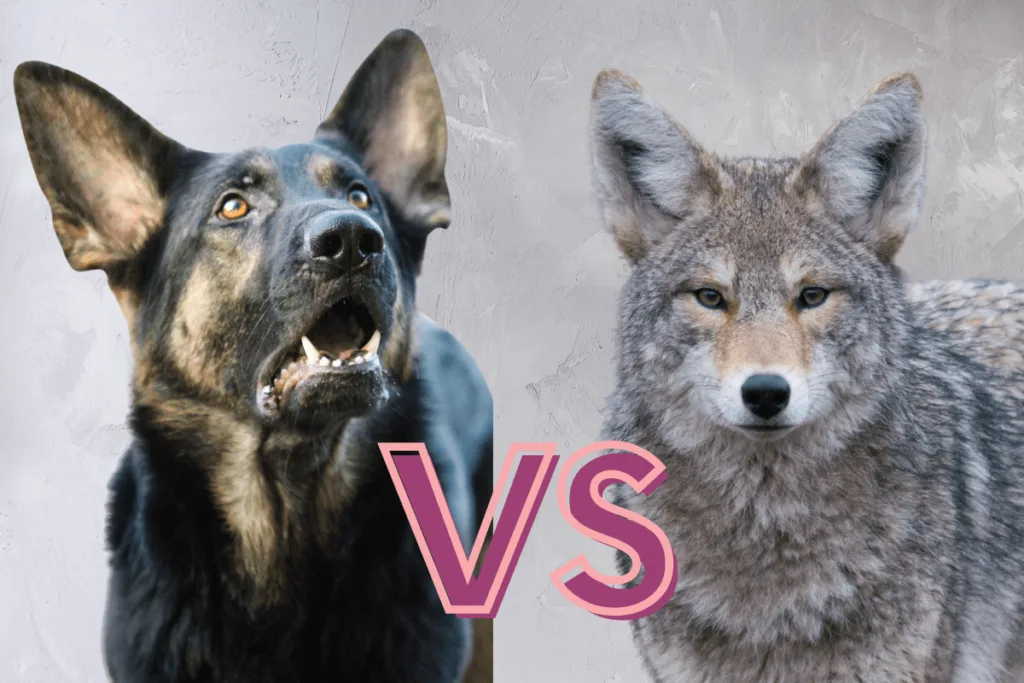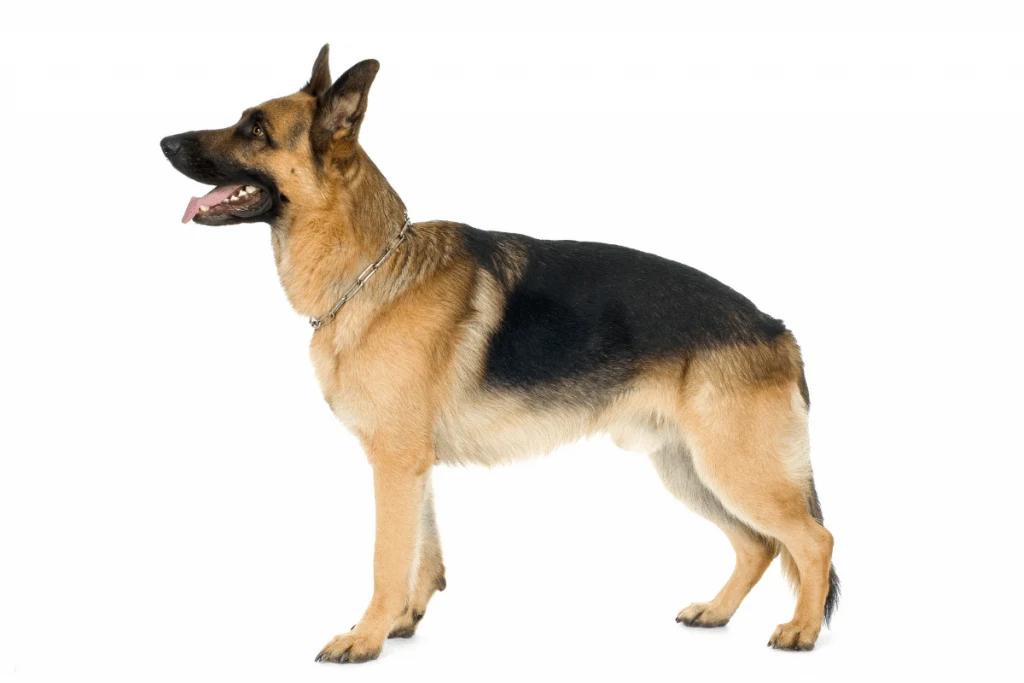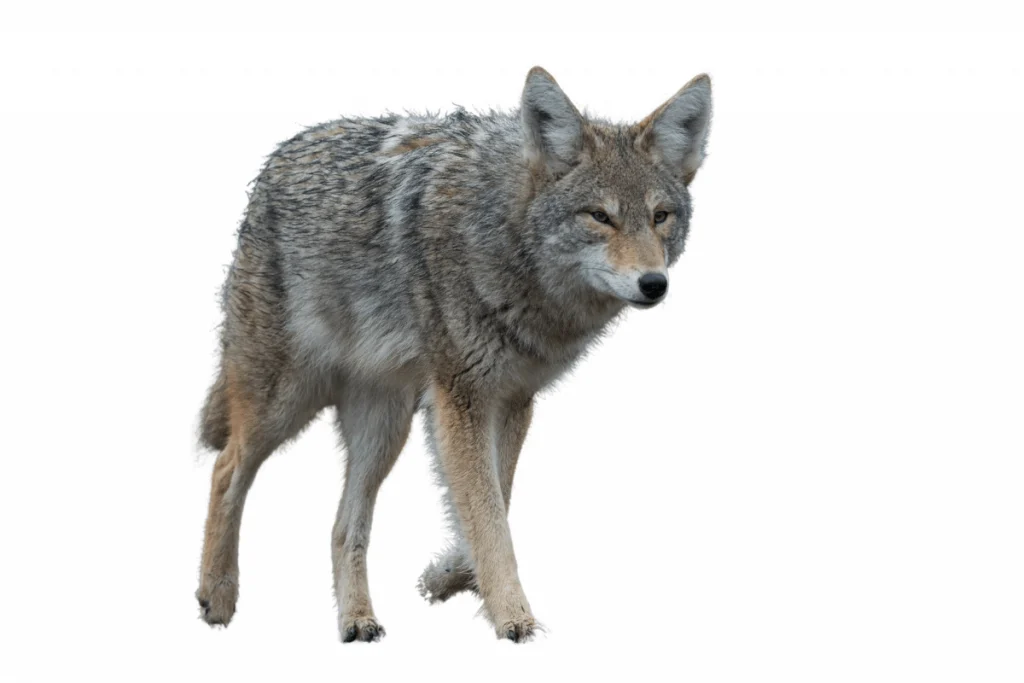
Many internet users wonder who would win in a fight between a German Shepherd and a Coyote.
In a fight between a coyote vs. German Shepherd, the winner could be either one. German Shepherds have strong protective instincts and will defend their territory. Coyotes are also territorial and often encroach on German Shepherd territory, but they don’t attack unless necessary.
This article will look at the different advantages and disadvantages each of these Canidae species has in a fight. We’ll also compare the German Shepherd and the coyote.
Click Here to Jump to a Section
German Shepherd vs. Coyote
There is no correct answer to the question of which between a German Shepherd and a coyote would win in a fight. The outcome of an altercation between a German Shepherd and a coyote could go either way, depending on multiple factors.
Age
For instance, the age of the German Shepherd can affect the outcome. If a full-grown adult male GSD (German Shepherd Dog) goes head to head against a young coyote, the Shepherd has a higher chance of winning.
Full-grown Shepherds are larger than coyotes.
But if a younger German Shepherd attempts to take on a seasoned, full-grown coyote, the Shepherd could be at a disadvantage, allowing the Coyote to win.
Experience
Coyotes have life experience on their side. Defending their territory, family, and food is a normal part of their lives. Dogs rarely have reason to fight for their possessions.
If a scuffle occurs between a coyote and a German Shepherd, most times, a Shepherd will turn tail and run to safety instead of continuing to fight.
However, if the German Shepherd stays to fight, it will take a lot of damage to make the Shepherd feel enough pain to give up. Depending on your Shepherd’s temperament, they may not give up until the coyote runs away or is dead.
A Shepherd Should Live Through a Fight
In most cases, a coyote will not fight to kill anything they deem a threat. They will make a lot of noise and puff up their bodies to appear larger to scare the danger away.
But if that method doesn’t work, a coyote will resort to fighting. They will attack hard enough that the threat backs out of the fight and won’t interlope on the Coyote’s territory anymore. But they rarely kill anything unless it’s a source of food.
If a German Shepherd ends up in a fight with a coyote, they may walk away harmed, but there’s a high chance they will come back alive.
If a German Shepherd gets into a fight with a wolf, on the other hand, it will be a bloody battle to the death. Your Shepherd likely wouldn’t survive.
Advantageous Features of German Shepherds

German Shepherds are a medium to large breed dog with wolfish body shape, short pointy ears, a long muzzle, and a bushy tail. Three distinct features about the GSD can make them a challenge in a fight against a coyote.
Deadly Bite
First, German Shepherds have powerful jaws, meaning a strong bite. The strength of a German Shepherd’s bite can easily top 238 psi.
That’s enough power to break any bone in the human body – or a coyote’s. Once a GSD latches on with their muscular jaws, their steel grip makes it challenging to get free without tearing off hunks of flesh.
Protective Instinct
GSDs also have a fierce protective instinct. If they feel those they guard are in danger, they will confront the threat and do everything in their power to eliminate it.
This instinct, plus their high pain threshold, make German Shepherds one of the most used dogs for law enforcement, search and rescue, and military service dogs.
But it can also make them brave enough to stand up to a wild coyote. And it also means they won’t back down until they feel the Coyote is no longer a threat.
For more detailed information about the role of German Shepherds as police dogs, military dogs, search and rescue, as well as service dogs, be sure to check out the following articles:
- Why Are German Shepherds Good Police Dogs?
- Are German Shepherds Good Service Dogs?
- Are German Shepherds Good Emotional Support Dogs?
Large Size
When comparing a German Shepherd and a coyote side by side, the German Shepherd has quite a height and weight advantage.
Female GSDs can grow up to 22” to 24” (55-60 cm) and weigh between 49-71 pounds (22-32 kg). Males range from 24” to 26” (60-65 cm) and weigh between 66-88 pounds (30-40 kg).
Features of Coyotes

Coyotes are not wild dogs, as many people assume. They are canids and belong to the Canidae species.
For the record, German Shepherds also fall into the Canidae classification, a family of carnivorans (an animal that eats flesh) with similar dog traits.
Coyotes share many physical similarities to a wolf, except they are smaller and not as aggressive. Other animals related to the Coyote are foxes, jackals, and domesticated (pet) dogs.
They have yellow eyes, bushy tails, lean bodies, and thick fur that may look matted and clumpy during certain parts of the year. Their muzzle is narrow and elongated with sharp teeth. However, they only have a bite strength of 153 psi, much less than a GSD.
Smaller Body
Coyotes have a smaller build than German Shepherds and fall into the medium size class. They can grow to be between 32” and 37” (81-94 cm). And they usually weigh between 20 and 50 pounds (9 to 23 kg). The tail of a coyote can grow up to 16” (41 cm) long.
The coat color for coyotes can range from brown, tan, gray, or white, depending on the coyote’s location. Coyotes that live in deserts have lighter coats than those living in the mountains.
Territorial
Coyotes often hunt in packs, although they are solitary creatures that are very territorial. They are nocturnal, meaning they sleep during the day and hunt at night.
Coyotes do not have a problem encroaching on areas where there is a human presence, as expansion has reduced the hunting grounds for many animals of this species, forcing them to adapt.
When a female dog goes into heat, any coyotes nearby can catch the scent and attempt to mate. Crossbreeding is possible between a coyote and a dog, including German Shepherds. However, it is not a recommended breeding habit.
Speed
If it came down to a fight between a coyote and a German Shepherd, the German Shepherd might be larger, but the Coyote is a bit faster. Coyotes can run at speeds up to 40 mph (64kph), whereas German Shepherds can only run up to 30 mph (48.3 kph).
German Shepherds may give chase to a coyote, but they will undoubtedly be outrun. But coyotes are cunning, and will use their lifetime of hunting and territorial skills to lay a trap for the Shepherd.
It’s not uncommon for one coyote to lure prey or an intruder into a perfect position for a whole pack of coyotes to ambush. Or the lone coyote may disappear in front, only to appear behind its target and attack.
When it comes to stamina, both the German Shepherd and the coyote can pursue a target for extended periods without tiring. And they both have an enhanced sense of smell that could help track their opponent.
Final Thoughts
If it came down to German Shepherd vs. Coyote, it’s a toss-up as to who would win in a fight. Both of these animals have advantages and disadvantages over each other.
The Shepherd has the size and protective instincts on their side, while the coyote has speed and experience.
The best course of action is to keep a close watch on your German Shepherd if there’s a coyote present, so you don’t have to answer this question from experience!
